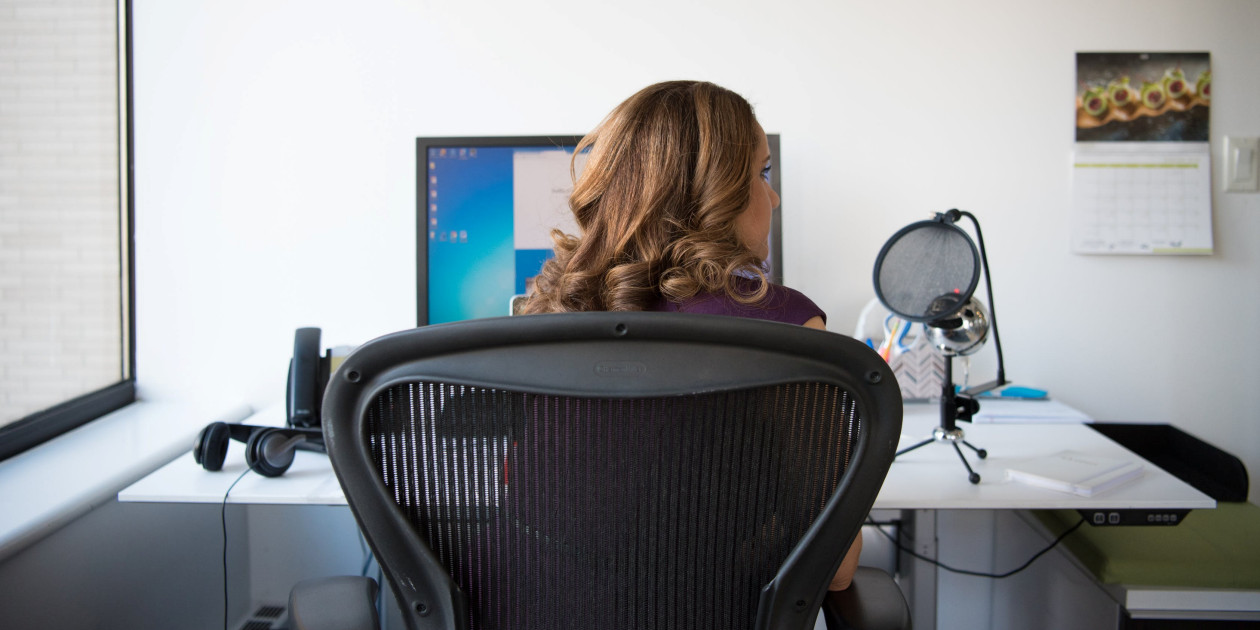If you work in an office, you know what sitting all day can do to your back. It aches, you’re stiff, and your legs are tired mostly because you didn’t get up often enough or take any long walks. This can all be attributed to poor ergonomics, poor body awareness and a poorly designed office chair. When you know your job requires sitting for long lengths of time, you need to choose the perfect ergonomic office chair. If you can’t control what chair you get, no worries. Here are some tips on what to look for in a proper ergonomic chair.

Fig. 1. Over-sized chairs are commonplace in most offices due to the lack of proper selection and fit.
1. Adjust Seat Height (all ergonomic chairs have this feature)
If your seat is too low, your elbows will be below your desk surface. You will be stretching to reach your desk, phone, and keyboard. This can quickly lead to issues such as shoulder pain and carpal tunnel from leaning on the desk or over-reaching.
If your seat is too high, you may start to slouch or have poor posture from typing all day. Your feet won’t be on the floor either, contributing to your back discomfort.
Find a chair with an adjustable seat height (5" range beginning at 15" or 16"H) so that you can find just the right height. Your arms will be bent at a 90-degree angle, at the elbow, when your seat is adjusted properly. Your feet should also sit flat on the floor. If you are on the short side, a small box or footrest can be used so that your legs aren’t dangling over the edge of the seat all day.
If you are constantly having to adjust the seat height because your chair sinks on its own with you in it, tell your supervisor or facilities manager. A failing cylinder is a sign of chair failure and is a safety risk!
2. Your Chair Should Have Adequate Width and Depth
A chair that is not wide enough for your hips or deep enough for your backside will not provide adequate support. To find a chair that is deep enough, the person sitting in it should have their back against the seat and their knees should be about 1-2 inches from the front of the seat, so you can get at least 2 fingers between the back of your knee and the front of your seat. If you are a very tall person, finding a seat that has an adjustable depth setting is important so that you have good weight distribution between your butt and your thighs. The same is true if you are very short, the seat should be able to be retracted so it doesn’t push into the back of your knees.
3. Lumbar Support is Necessary
When you are sitting for a long time, a chair that has adequate lumbar support will protect your back. To maintain the natural inward curve or the lumbar curve of your spine, an adjustable lumbar support should be included with a proper ergonomic office chair. While lumbar supports can be purchased as accessories, adjustable ones are best for those who sit for extended periods of time on a regular basis. Bottom line is the chair should provide adequate back support by raising or lowering the back rest or inflating a lumbar bladder. If you have to buy additional support, you are either not adjusting it correctly or the chair just doesn’t fit!

Fig.2. Placing the keyboard outside near reach and above elbow height will require a forward leaning posture contributing to back fatigue. Keep keyboard and mouse close to front edge of desk and sit to the back of the chair with good support.
4. Arm Rests
Arm rests can help you maintain your upright posture, unload your upper back and torso and help you get in and out of your chair. But, in order to work for you, they must fit! You should be able to be comfortably seated, with your back against the seat and your feet on the floor with your arms supported adjacent to your trunk, shoulder in line with elbow supported on the armrest intermittently, without it pushing your shoulders upward. Whether you are tall or short, chairs with adjustable arm rests can be beneficial to ensure that your arms are at a 90-degree bend to help you avoid leaning on your desk while you are mousing and using your keyboard.
5. Seat Comfort
If you are sitting on something that mimics concrete all day long, your back and legs will ache. An ergonomic office chair should have enough cushion for back/buttock/hip support. It should not be something that you sink into like a feather pillow, nor should it be something so firm it hurts or causes numbness. Many people prefer a plastic mesh weave for better air flow and reduced heat buildup when seated. Some fabrics are breathable while others can contribute to increased body temperature like vinyl.
6. All Chairs Swivel for a Reason
If you are constantly moving about the office, have two monitors, or a u-shaped desk, a chair that swivels is a great asset. Getting a swivel seat will help to keep you from straining while reaching for things. If you can turn your entire seat, rather than twist your back, you will prevent injury.
Choose Wisely and Sit Comfortably
While you may not be able to control the chair assigned to you in your workplace, it is critical you understand how to use and adjust it for a good fit. If you are fortunate to have the opportunity to buy a chair for yourself, whether you invest $200 or $1000, make sure it fits, is comfortable and has easily adjustable features to support your body. After all, an ergonomic chair is foundational to good ergonomics and seated work health so choose wisely and sit comfortably for long lasting health!
To learn more about office ergonomics and chair assessment, selection and fit, visit www.worksiteinternational.com or contact Alison Heller-Ono at alisonh@worksiteinternational.com. Check out the following website for chairs under $200.00.https://www.gadgetreview.com/best-office-chair-under-200. *(products selected are not necessarily endorsed by Worksite International, Inc.)


Comments (9)